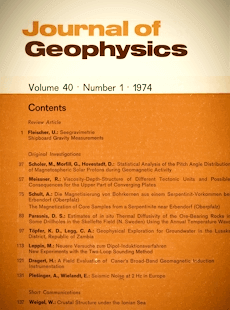Long-wavelength aeromagnetic anomalies and deep crustal magnetization in Manitoba and Northwestern Ontario, Canada
Article Sidebar

Vols. 1-18 (1924-1944), ISSN 0044-2801
Main Article Content
Abstract
A new type of aeromagnetic anomaly map (a long-wavelength anomaly map with anomaly widths in the range 60 km < λ < 4000 km) is presented for the area. It is believed that this group of anomalies represents a physically distinct field. This field shows considerable correlation with the broad features of deep crustal structure as derived from seismic sounding; linear relationships were found between the field and depths to the bottom of the crust and to the boundary between the upper and the lower crustal layers, as well as to the thickness of the lower crustal layer. A theoretical relationship connecting structure on magnetized layers to magnetic anomalies is given showing that the linear relationships are to be expected. It is shown that the lower crustal layer is the most likely source of the anomalies, with an intensity of magnetization of 5.3 X 10-3 emu/cc. It is also indicated that the upper crustal layer could also be the source, but that a shallow plate of magnetization could not explain the anomalies. Thus deep crustal magnetization must (on all interpretations made in the present paper), be responsible for the long-wavelength anomalies. Also, these anomalies are strongly related to major features in surface geology.
 ARK: https://n2t.net/ark:/88439/y012135
ARK: https://n2t.net/ark:/88439/y012135
Permalink: https://geophysicsjournal.com/article/171
Article Details
References
Birch, F. (1961) Composition of the Earth's Mantle: in The Earth Today; Royal Astronomical Society, 295-311
Brown, R.J. (1968) lsostasy and crustal structure in the English River gneissic belt: Unpublished M. Sc. Thesis. University of Manitoba
Coles, R.L. (1973) Relationships between measured rock magnetizations and interpretations of longer wavelength anomalies in the Superior province of the Canadian Shield. Unpublished Ph.D. thesis, University of Manitoba, 215 p.
Davidson, A. (1972) The Churchill Province: in Variations in Tectonic Styles in Canada, 382-388
Dominion Observatories Branch (1965) F-isodynamic chart, Canada
Hajnal, Z. (1969) A two-layer model for the earth's crust under Hudson Bay; In Earth Science Symposium on Hudson Bay, P. J. Hood (ed.) Geological Survey of Canada paper, 326-336
Hall, D.H., Dagley, P. (1970) Regional magnetic anomalies; An analysis of the Smoothed Aeromagnetic Map of Great Britain and Northern Ireland. Institute of Geological Sciences, Report 70/10
Hall, D.H. (1968a) Regional magnetic anomalies, magnetic units, and crustal structure in the Kenora District of Ontario. Can. J. Earth Sci. 5:1277-1298
Hall, D.H. (1968b) A seismic-isostatic analysis of crustal data from Hudson Bay, in Earth Science Symposium on Hudson Bay, P. J. Hood, Ed. Geological Survey of Canada Paper 68-53:337-364
Hall, D.H. (1968c) A magnetic interpretation method for calculating body parameters for buried sloping steps and thick sheets. Geoexploration. 6:187-206
Hall, D.H. (1971) Geophysical determination of deep crustal structure in Manitoba. The Geological Association of Canada, Special Paper No. 9:83-88
Hall, D.H. (1969) In preparation 1974 Hall,D.H., Hajnal,Z.: Crustal Structure of northwestern Ontario. Refraction seismology. Can. J. Earth Sci. 6:81-99
Hall, D.H., Hajnal, Z. (1973) Deep seismic crustal studies in Manitoba. Bulletin of the Seismological Society of America 63:885-910
Hall, D.H., McGrath, P.H., Richards, D.J. (1974) Regional Magnetic anomalies in Manitoba. Manitoba Mines Branch (In press)
Malahoff, A. (1969) Magnetic Studies over Volcanoes. Hawaii Institute of Geophysics Contribution 198:436-446
McGrath, P.H., Hall, D.H. (1969) Crustal structures in northwestern Ontario: Regional magnetic anomalies. Can. J. Earth Sci. 6:101-107
Mereu, R.F., Hunter, J.A. (1969) Crustal and upper mantle structure under the Canadian Shield from Project Early Rise. Bull. Seism. Soc. Am. 59:147-165
Morley, L.W., MacLaren, A. (1967) Magnetic anomaly map of Canada. Map number 1255A
Nagata, T. (1961) Rock Magnetism, Revised Edition, 350 pp., Tokyo: Maruzen Co.
Regan, R.D. (1974) World Wide Magnetic Anomalies from Pogo and Cosmos Data, IAGA Second General Scientific Assembly
Wilson, H.D.B. (1971) The Superior Province in the Precambrian of Manitoba. The Geological Association of Canada, Special Paper, No. 9:41-49
Zietz, I., Andreasen, G.E., Cain, J.C. (1970) Magnetic anomalies from satellite magnetometer. J. Geophys. Res. 75:4007-4017











